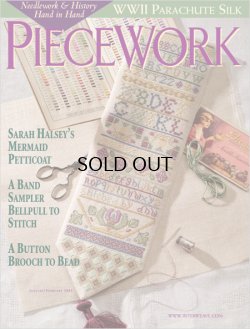PieceWork, January/February 2003
PieceWork, January/February 2003
販売価格: 800円(税込)
SOLD OUT 売れました。
送料 180円 3冊以上 エクスパック 500円
5冊以上は一冊 600円 10冊以上は一冊 500円
送料はなるべく安く送ります。
Table of Contents
Articles
- Sarah Halsey's Mermaid Petticoat- During the eighteenth century, it was fashionable for women to wear an "open robe," a dress that revealed a decorative petticoat underneath. A quilted petticoat made by Sarah Halsey, now in the collection of the Connecticut Historical Society, depicts both real and fanciful animals, including a stag, a lion, a leopard, and a mermaid with a comb and mirror. (Lynne Zacek Bassett)
- Norway's Embroidered Bunader- More than 400 regional communities in Norway have developed bunader, distinctive attire worn solely on festive occasions. Symbols of both regional and national identity, bunader commonly feature elaborate embroidery on their bodices, skirts, shirts, aprons, and caps. (Ann Schmiesing)
- Taste, Art, and Design in Great Britain from l500 to l900- The recently renovated British Galleries at the Victoria and Albert Museum in London chronicle the aesthetic history of Great Britain between l500 and l900. Fifteen galleries contain some 3,000 objects, including clothing and textiles ranging from a circa l590 blackwork smock to nineteenth-century designs for wallpaper and textiles by William Morris. (Deborah Pulliam)
- A Wedding Dress from a Parachute- In Holland during the summer of l945, Wilhelmina Vanden Berg and Bill van Niekerk were planning their wedding, but finding fabric for a wedding dress was nearly impossible because of the terrible shortages resulting from World War II. A few months before the wedding, an American Liberator bomber crash-landed near Bill's village, and a parachute pack left behind by one of the crew furnished the silk fabric that Wilhelmina used to make her wedding dress, underwear for Bill, and a christening dress for their first child. (David Bly)
- Reflections on Little Girls and Their Sewing for Dolls- In this second article based on the exhibition "Reflections: Fashion, Dolls, and the Art of Growing Up" at the American Textile History Museum, Lowell, Massachusetts, curators Deborah Kraak and Barbara Abrams explore how sewing for dolls taught nineteenth-century girls skills they would rely on as adults. (Deborah E. Kraak and Barbara C. Abrams)
- A Lion Motif to Quilt- This whimsical lion, presented on the lid of a Shaker box and quilted with a back-stitch variation to enhance detail, was adapted by Meg Grossman from a motif on Sarah Halsey's petticoat.
- A Gentleman's Waistcoat to Crochet- This double-breasted crocheted vest, adapted from Weldon's Practical Needlework, Volume 2, is as fashionable today as it was in the late nineteenth century. Designer Bart Elwell has combined two solid-colored yarns to create the vest's variegated colors.
- A Swiss Collar to Knit- Many of the traditional costumes of Swiss immigrants include a knitted lace scarf worn as a collar over a bodice. This knitted collar, inspired by one found in the Swiss Village Museum in New Glarus, Wisconsin, was adapted from a collar published in Folk Vests, by Cheryl Oberle (Loveland, Colorado: Interweave Press, 2002).

